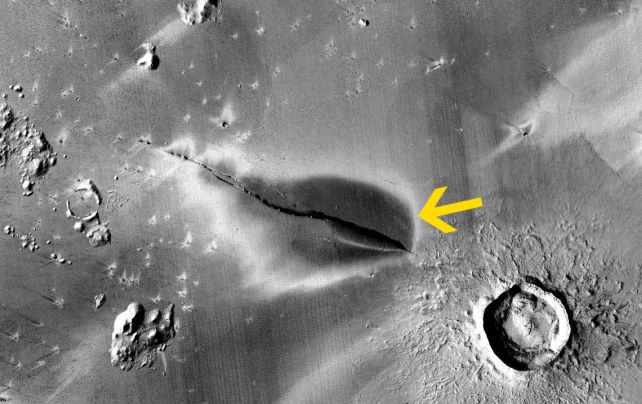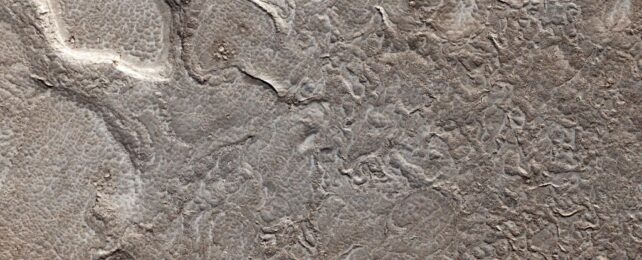It's time to put the notion of a cold, lifeless Mars to bed.
A new survey using satellite imagery and ground penetrating radar has revealed signs of volcanic activity that's far more recent than anyone ever expected.
Combined with other pieces of evidence, the discovery reveals that under its barren crust, Mars might have quite a bit more going on than outside appearances suggest.
The study, conducted over a plain known as the Elysium Planitia, reveals volcanic activity that has taken place within the last 120 million years. In fact, some of the identified volcanic activity has been dated to just 1 million years ago.
That's very recent, geologically speaking; and, although we have yet to observe any volcanic activity actually taking place, it suggests that, somewhere on Mars, it might be.
"Elysium Planitia was volcanically much more active than previously thought and might even still be volcanically alive today," explains planetary scientist Joana Voigt of NASA's Jet Propulsion Laboratory, who co-led the study alongside planetary scientist Christopher Hamilton of the University of Arizona.
The surface of Mars at Elysium Planitia is pretty interesting, if you like rocks (and who doesn't). Some of the lava flows over the surface appear to be remarkably young, something that somewhat baffled scientists when they noticed it.
The landscape also appears to have features carved out by lava interacting with ice or liquid water, causing steam explosions. This is very interesting, because terrestrial landscapes that combine hot geological activity with water, such as hot springs, are unexpectedly thriving with microbial life.
The parallels between Earth and Mars have not gone unnoticed, and scientists think life could emerge in these landscapes.
To make a bit more sense of the volcanic history of the region, the researchers combined data from multiple instruments: topographic maps to reveal the shape of the surface, satellite imagery to study features, and ground-penetrating radar to obtain density maps up to 140 meters (460 feet) below the surface.
"Elysium Planitia is the perfect location to try to understand the link between what we see at the surface and the interior dynamics that manifested itself through volcanic eruptions," Voigt says.
"I paid a lot of attention to the details on the lava surfaces to try and untangle the different eruption events and reconstruct the entire history of these geologic entities."

The survey allowed the researchers to map and reconstruct each individual lava flow in the Elysium Planitia in 3D, revealing that the landscape is is composed of material from more than 40 volcanic events between 120 million and 1 million years ago.
Some of these were absolutely epic. One eruption flooded Rahway Valles with over 16,000 cubic kilometers (3,840 cubic miles) of molten basalt; another with 12,200 cubic kilometers in Marte Vallis. A third flooded Athabasca Valles with 4,000 cubic kilometers of molten rock.
Although Mars seems dry now, the vents that allowed this lava to flow could have released catastrophic floods of groundwater at the same time, producing extremely explosive events that shaped the landscape. Here on Earth, the addition of steam results in some of the most explosive volcanic eruptions.
"When there is a crack in the Martian crust, water can flow onto the surface," Hamilton explains. "Because of the low atmospheric pressure, that water is likely to literally just boil away. But if there's enough water coming out during that period, you can get a huge flood that comes through, racing over the landscape and carving out these huge features that we see."
Previous studies have shown that volcanic features on the surface of the Elysium Planitia could be as young as just 50,000 years old. We've also seen, thanks to seismic data collected by the now-retired Mars InSight lander, that Mars has a surprising amount of quake activity, some of which has been traced to volcanism. Quite large volcanism.
The new findings indicate that Elysium Planitia is not just vital for understanding the volcanic history of Mars, but also where its water might be hiding. The team's findings suggest that large water ice deposits may be lurking underground there, even today.
"The young volcanic surfaces and the recent detection of seismic activity in Elysium Planitia could imply that Mars is still volcanically active," they write in their paper.
"With its very recent geologic activity, Elysium Planitia is an exceptionally important region that is vital for understanding the past and current volcanological and magmatic state of Mars in addition to its recent aqueous history."
The research has been published in JGR Planets.
